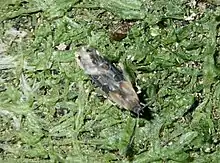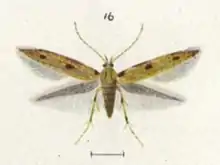Circoxena ditrocha
Circoxena ditrocha is a species of moth in the family Blastodacnidae. This species is endemic to New Zealand. It is classified as "At Risk, Naturally Uncommon" by the Department of Conservation.
| Circoxena ditrocha | |
|---|---|
 | |
| Scientific classification | |
| Kingdom: | |
| Phylum: | |
| Class: | |
| Order: | |
| Family: | |
| Genus: | Circoxena |
| Species: | C. ditrocha |
| Binomial name | |
| Circoxena ditrocha | |
Taxonomy

This species was first described by Edward Meyrick in 1916 using a specimen collected by George Hudson at Wainuiomata in December.[2] Hudson discussed and illustrated the species in his 1928 publication The butterflies and moths of New Zealand.[3] In 1973 John S. Dugdale discussed the species and illustrated the wing venation as well as the genitalia of both the male and female.[4] The holotype specimen is held at the Natural History Museum, London.[5]
Description
Meyrick described this species as follows:
♀︎. 11 mm. Head dark shining bronze. Palpi and antennae white lined with black. Thorax dark bronzy-fuscous, external edge of patagia white. Abdomen dark grey. Forewings elongate-lanceolate, fuscous, suffusedly streaked longitudinally with blackish ; a fine white longitudinal line just beneath costa on basal fourth, costal edge black ; dorsum white towards base ; a light yellow-ochreous patch occupying basal third of wing from near costa to fold, marked with three fine whitish longitudinal lines diverging from base ; two large fine whitish rings in disc before middle and about 2⁄3 ; a small black apical spot preceded by some whitish suffusion : cilia on costa dark grey, basal half barred with ochreous-whitish, on termen ochreous-whitish tinged with grey towards tips and basal area barred with grey. Hindwings grey, becoming dark grey towards apex : cilia whitish-grey.[2]
Alfred Philpott studied and described the male genitalia of the species in 1927.[6]
Distribution
This species is endemic to New Zealand.[7][1] It has been found from Auckland to Invercargill.[8]
Biology and behaviour
The adults of this species have been found on the wing in December and March.[8] Hudson noted that C. ditrocha was a sluggish flyer and could be collected by sweeping foliage.[3]
Host plants and habitat
The host plants of the larvae of this moth are unknown, but the larva may be a seed borer.[9] Adults of this species prefer habitat at the edges of forest or scrub and appear to be associated with Pseudopanax arboreus.[3][8]
Conservation Status
This species has been classified as having the "At Risk, Naturally Uncommon" conservation status under the New Zealand Threat Classification System.[10]
References
- "Circoxena ditrocha Meyrick, 1916". www.nzor.org.nz. Landcare Research New Zealand Ltd.
- Meyrick, Edward (1916). "Descriptions of New Zealand Lepidoptera". Transactions and Proceedings of the New Zealand Institute. 48: 414–419 – via Biodiversity Heritage Library.
- Hudson, G. V. (1928). The Butterflies and Moths of New Zealand. Wellington: Ferguson & Osborn Ltd. pp. 331–332.
- Dugdale, John S. (1973). "The genus Plutella (Hyponomeutidae) in New Zealand and the family position of Circoscena (Lepidoptera)". New Zealand Journal of Science. 16: 1009–1023.
- Dugdale, J. S. (1988). "Lepidoptera-annotated catalogue, and keys to family-group taxa" (PDF). Fauna of New Zealand. 14: 1–264 – via Landcare Research New Zealand Ltd.
- Philpott, A. (1927). "The Male Genitalia of the New Zealand Plutellidae" (PDF). Transactions and Proceedings of the New Zealand Institute. 58: 317–326.
- Gordon, Dennis P., ed. (2010). New Zealand inventory of biodiversity. Volume two. Kingdom animalia : chaetognatha, ecdysozoa, ichnofossils. Vol. 2. Christchurch, N.Z.: Canterbury University Press. p. 457. ISBN 9781877257933. OCLC 973607714.
- Pawson, Stephen M.; Emberson, Rowan M. (2000). The conservation status of invertebrates in Canterbury (Report). Department of Conservation. p. 41. hdl:10182/1658. ISSN 1171-9834.
- Patrick, B. H.; Dugdale., J. S. (2000). "Conservation status of the New Zealand Lepidoptera" (PDF). Science for Conservation. 136: 21. ISBN 0478218672. ISSN 1173-2946. Archived from the original (PDF) on 2017-05-01. Retrieved 2018-01-18 – via Department of Conservation.
- Hoare, R.J.B.; Dugdale, J.S.; Edwards, E.D.; Gibbs, G.W.; Patrick, B.H.; Hitchmough, R.A.; Rolfe, J.R. (2017). "Conservation status of New Zealand butterflies and moths (Lepidoptera), 2015" (PDF). New Zealand Threat Classification Series. 20: 8.
External links
| Wikimedia Commons has media related to Circoxena ditrocha. |
| Wikispecies has information related to Circoxena ditrocha. |